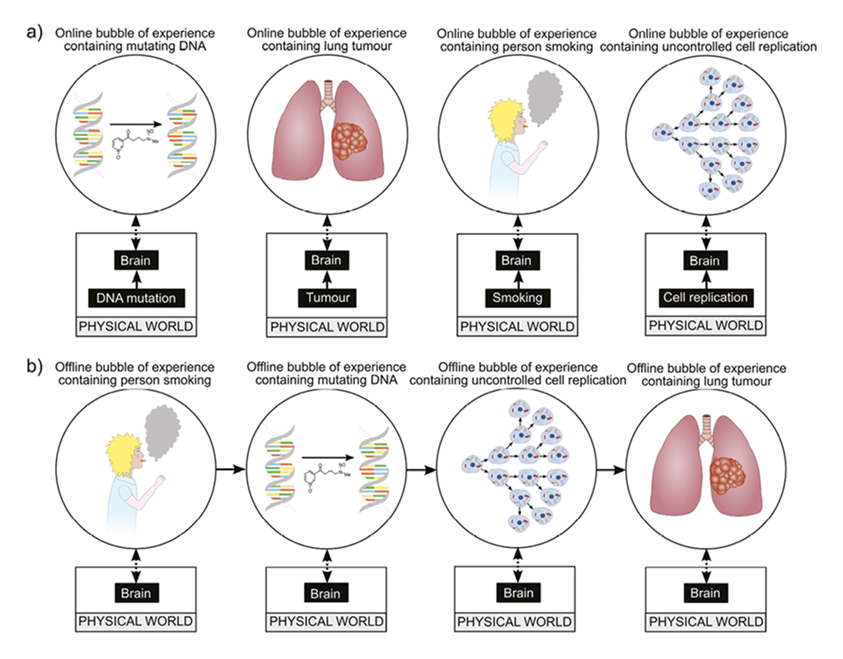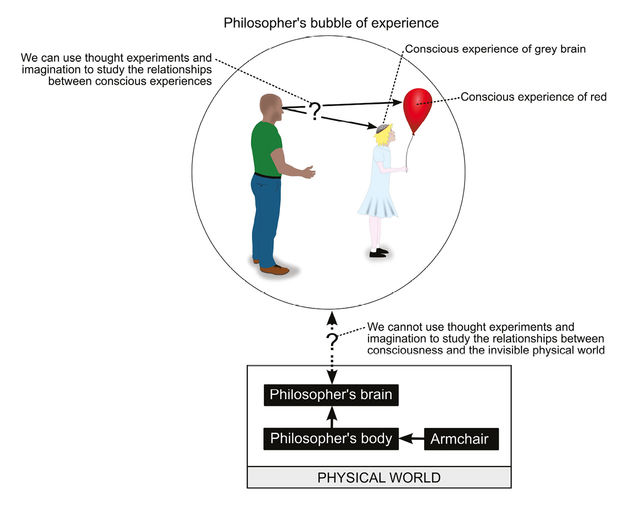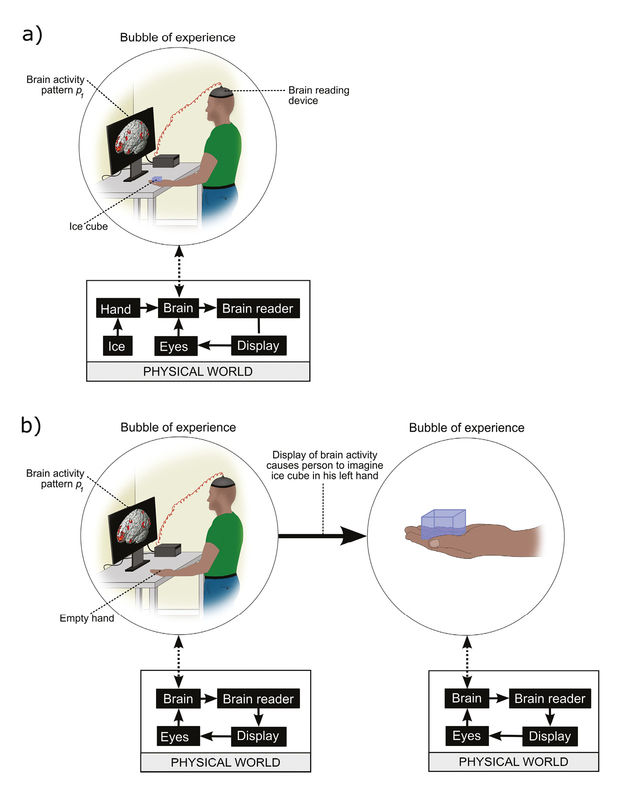3. The Philosophy and Science of Consciousness
© David Gamez, CC BY 4.0 https://doi.org/10.11647/OBP.0107.03
3.1 Understanding Consciousness
How should I understand and explain my wife? I can describe the changes in her hair and skin colour as she moves about in the light. I can objectify her body or relate to her as the Other—she faces me, crushes me, makes me feel guilty. I can use Eros and Thanatos to analyze her psychology, or interpret her mind as an intricate neural mechanism. I can provide an evolutionary explanation of her features (noting a trace of Homo heidelbergensis in her face).
How should we understand and explain consciousness?
Phenomenologists bracket off the physical world and describe the structure of consciousness from a first-person perspective.1 The starting point for phenomenology is our immersion in conscious experience; the end point is a description of consciousness that sets aside scientific theories about the physical world.
Science has triumphed in the last three hundred years. We send people to the moon and grow babies in test tubes. Many people believe that science provides a complete description of the world. The predictive success of science exerts a commanding weight: we believe in the physical world; we are convinced by our scientific explanations and cannot ignore them. We need phenomenological descriptions of consciousness, but we cannot bracket out scientific theories. Phenomenology is not enough.
Many people explain consciousness by reducing it to features of the physical world.2 This is not convincing. It is far from obvious that colours, sounds and smells can be reduced (with a wave of the hand) to wave-particles, superstrings or fields. Colour appears in consciousness when colourless electromagnetic waves interact with the physical sense organs and change the brain’s activity. But brain activity is silent and without smell. Colour and smell are linked to brain activity; they are not identical to colourless odourless brain activity.
Bubbles of experience and the physical world are both important phenomena. It would be premature to bracket either out or to claim that one can be reduced to the other. Both have to be taken seriously. We have detailed descriptions of consciousness and a good understanding of the physical world—the key gap in our knowledge is the relationship between them.
3.2 The Limits of Imagination
Imagination is an offline bubble of experience.3 We can change the contents of this bubble of experience without changing our physical environment. We fill it with novel things—recombine the elements of our experience in new ways. As I sit at my desk I imagine that I have lost my limbs and lie naked on a rocky plain beneath a burning sky. A raven is feeding on my liver.
We use our imagination to solve scientific problems. On separate unrelated occasions mutating DNA, tumours, cigarette smoke and unregulated cell growth appear in my bubble of experience. I use my empirical knowledge about the links between these phenomena to visualize the correct sequence from smoking to the appearance of a tumour. I do not need direct knowledge of the physical world to do this. It is enough that the appearance of cigarette smoke in my bubble of experience corresponds to the presence of smoke in the physical world, that the appearance of mutating DNA in my bubble of experience corresponds to the presence of mutating DNA in the physical world, and so on (see Figure 3.1). We have an intuitively satisfying explanation of the relationship between phenomena when we can visualize the intermediate steps between them.

Figure 3.1. The use of imagination to solve a scientific problem. a) On separate occasions mutating DNA, tumours, cigarette smoke and unregulated cell growth appear in my bubble of experience. I observe sequential relationships between pairs of these phenomena, but never the whole story. b) My empirical knowledge about the connections between these phenomena enables me to imagine the correct sequence of steps from smoking to the appearance of a tumour in the lungs. Image © David Gamez, CC BY 4.0.
Online and offline bubbles of experience have the same properties—colour, smell, taste, sound and body sensations. These are typically less intense in offline bubbles of experience and some are not present at all. Objects can vary in wild ways in an offline bubble of experience, but we cannot imagine new properties. We cannot imagine properties that we have not encountered in an online bubble of experience.
Imagination is an inductive engine that reassembles previous experiences. We can imagine pigs playing the piano because we have seen pigs and pianos before. If we had never seen pianos and pigs, then it is unlikely that piano-playing pigs would enter our imagination.4
We have a limited ability to wilfully transform our offline bubbles of experience. It is difficult to imagine radically different forms of consciousness. It is difficult or impossible to wilfully morph our bubbles of experience into a bat’s bubble of experience (assuming it has one).5
We cannot imagine things that cannot become conscious. We cannot imagine an invisible physical world that has none of the properties that we encounter in our bubbles of experience. We can imagine large brains, small brains, blue brains, green brains, brains made of cheese, and so on. But the physical brain cannot be imagined as it is in itself, outside all bubbles of experience.6
3.3 A Failure of Imagination
How is it possible for conscious states to depend upon brain states? How can technicolour phenomenology arise from soggy grey matter? What makes the bodily organ we call the brain so radically different from other bodily organs, say the kidneys—the body parts without a trace of consciousness? How could the aggregation of millions of individually insentient neurons generate subjective awareness? We know that brains are the de facto causal basis of consciousness, but we have, it seems, no understanding whatever of how this can be so. It strikes us as miraculous, eerie, even faintly comic. Somehow, we feel, the water of the physical brain is turned into the wine of consciousness, but we draw a total blank on the nature of this conversion. Neural transmissions just seem like the wrong kind of materials with which to bring consciousness into the world, but it appears that in some way they perform this mysterious feat.
Colin McGinn, Can We Solve the Mind-Body Problem?7
In 1989 the philosopher Colin McGinn asked the following question “How can technicolor phenomenology arise from soggy gray matter?” […] Since then many authors in the field of consciousness research have quoted this question over and over, like a slogan that in a nutshell conveys a deep and important theoretical problem. It seems that almost none of them discovered the subtle trap inherent in this question. The brain is not gray. The brain is colorless.
Thomas Metzinger,
Consciousness Research at the End of the Twentieth Century8
With furrowed brow, buried deep in his leather-bound armchair, the Philosopher seeks to untangle the mysteries of consciousness. One of the greatest and hardest problems of his time, or so he has read. He imagines the physical world, a grey lifeless sort of place. He imagines the brain, a squishy grey thing floating dismally in the air above his dirty glass coffee table. He imagines the colour RED. Bracing himself for the challenge, he attempts to solve the Hard Problem of Consciousness. Many have failed before him, but his obvious brilliance and intellectual arrogance will surely enable him to triumph. Perspiration breaks out on his brow. ‘Gee this is a tough one.’ He struggles to imagine how activity in the grey brain could cause or be the colour red. Or how the colour red could be reduced to activity in the grey brain. He changes position, scratches his crotch, picks his nose. He is sure that he can solve it, write that brilliant paper, receive the rapturous admiration of his peers. ‘Just a bit more time; perhaps a coffee will help.’
The relationship between consciousness and the physical world is often addressed in a thought experiment in which we bring to mind an image of the brain (coloured grey) and an image of something conscious (the colour red), and try to imagine how they are related. This is often described as a hard problem of consciousness because it is impossible for us to imagine how neural activity could cause or be the colour red.9
The physical brain has none of the properties that are present in consciousness. It is not grey; it is not soggy—it is invisible and cannot be imagined by us. So thought experiments and imagination cannot be used to study the relationship between invisible physical brains and conscious experiences. They can only be used to study the relationship between our conscious experiences of brains and other conscious experiences. This is illustrated in Figure 3.2.
3.4 Regularities in Conscious Experiences
We can observe regularities in our conscious experiences. Suppose I am connected to a device that shows the state of my brain on a screen. When an ice cube is placed in my left hand I observe brain pattern p1 on the screen. When I have memorized p1 I can make an imaginative transition from p1 to a cold sensation: whenever I think about p1 I imagine an ice cube. This is illustrated in Figure 3.3.10

Figure 3.2. Imagination cannot be used to understand the relationship between consciousness and the invisible physical world. A philosopher imagines a child with her brain exposed holding a red balloon. He wants to understand the relationship between the colour red and the invisible physical brain, but he can only imagine the relationship between the colour red and his conscious experience of a grey brain. Image © David Gamez, CC BY 4.0.

Figure 3.3. Learnt association between consciously experienced brain activity and the sensation of an ice cube. a) The subject wears a device that displays his brain activity on a screen. When an ice cube is placed in his left hand he observes and memorizes the brain pattern, p1, that appears on the screen. b) At a later time the subject views p1 when he is not holding an ice cube. He makes an imaginative transition from his conscious experience of p1 to a conscious experience of an ice cube. Image © David Gamez, CC BY 4.0.
We find it hard to imagine how our conscious experiences of brains are related to other conscious experiences because we have had little exposure to this relationship.11 Imagination is an inductive engine—it needs to be exposed to an association between A and B before it can imagine a transition from A to B. As technology develops we will have more conscious experiences of brain activity, which will enable us to develop intuitive links between our conscious experiences of brain patterns and other conscious experiences. This is nicely illustrated by Rorty’s example of the Antipodeans:12
In most respects, then, the language, life, technology, and philosophy of this race were much like ours. But there was one important difference. Neurology and biochemistry had been the first disciplines in which the technological breakthroughs had been achieved, and a large part of the conversation of these people concerned the state of their nerves. When their infants veered towards hot stoves, mothers cried out, “He’ll stimulate his c-fibers.” When people were given clever visual illusions to look at, they said, “How odd! It makes neuronic bundle G-14 quiver, but when I look at it from the side I can see that its [sic] not a red rectangle at all.” Their knowledge of physiology was such that each well formed sentence could easily be correlated with a readily identifiable neural state.13
We can observe regularities in our consciousness without raising hard philosophical problems. But our rudimentary brain scanning technology does not show us the relationship between conscious experiences of brain activity and other conscious experiences, so we cannot imagine this relationship. The Antipodeans have better access to their brains, so they can easily imagine the connection between activity in neuronic bundle G-14 and a conscious experience of a red rectangle.14
3.5 Brute Regularities
We might still ask how or why activity in the physical brain is linked to conscious states.
When we observe a connection between two physical events we can typically drill down to a more detailed account of the relationship between them. In the smoking example, we can fill in the link between cigarette smoke and DNA mutations with a more detailed story about biochemical reactions, which can be explained in terms of atomic and subatomic events. We can have conscious experiences that very roughly correspond to each intermediate stage.
In the case of consciousness we are looking for a relationship between something that is physical and properties that are not attributed to the physical world (colour, smell, etc.). However much data we gain about consciousness and the brain there is bound to be a gap in the imaginative story. We can learn everything there is to know about links between conscious experiences of brain activity and other conscious experiences, but we will still reach a point at which we simply have to accept that a particular brain state is connected with a particular conscious state. A physical brain activity pattern could simply be associated with red—this might be a brute regularity that cannot be broken down and analyzed any further.
Brute regularities exist in the other sciences. At a certain point we simply have to accept that the physical world works in a way that we can describe but cannot explain. For example, the behaviour of superstrings or elementary wave-particles can be described but not explained—it is the starting point for higher level physical explanations.15 Scientists cannot say why physical brute regularities exist. They are simply how the universe works.
Physics gives a detailed hierarchical description of the relationships between physical things, ranging from the interactions between elementary wave-particles up to the behaviour of planets and galaxies. Brute regularities lie at the bottom of this hierarchy—at the level of superstrings and elementary wave-particles.16
Our understanding of the relationship between consciousness and the physical world is at an early stage of development. We have no idea what the brute regularities of consciousness science will be. They could be simple relationships between novel physical properties and atoms of conscious experience, or they could be more complex regularities linking distributed brain activity patterns to complex conscious experiences.
Some people think that brute regularities are hard problems. But genuine brute regularities are not problems at all. They are basic facts about the way the universe works. Other phenomena pose problems that can be solved in terms of brute regularities. The brute regularities themselves can only be described—they cannot be understood or explained.
3.6 Summary
Idealists reject the physical world; phenomenologists suspend judgement about it; physicalists claim that consciousness is the physical world. None of these positions is convincing. Consciousness and the physical world both have to be taken seriously as real phenomena. We can study the relationship between them and suspend judgement about the metaphysical debates.
We cannot imagine the invisible physical world. So thought experiments and imagination cannot be used to study the relationship between invisible physical brains and conscious experiences. They can only be used to study the relationship between our conscious experiences of brains and other conscious experiences. As brain-scanning technology improves we will find it easier to make imaginative transitions between conscious experiences of brain states and other conscious experiences.
At some point the science of consciousness will encounter brute regularities in the relationship between consciousness and the physical world that can be described, but not explained. Brute regularities exist in the other sciences. We have no idea what the brute regularities of consciousness science will be.
The rest of this book suggests how a systematic science of consciousness can be developed. We can measure consciousness, measure the physical world and develop mathematical theories of the relationship between these measurements. Scientists measure consciousness using first-person reports, which raises traditional philosophical problems of zombies, solipsism, colour inversion and inaccessible consciousness. These problems cannot be solved, but they can be neutralized using the framework of definitions and assumptions that is set out in the next chapter.







